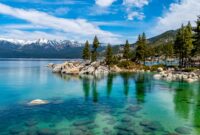Senior Travel Tours USA opens up a world of exciting possibilities for retirees seeking enriching experiences. This guide delves into the diverse options available, from meticulously planned escorted tours to independent adventures, catering to a range of budgets and preferences. We’ll explore popular destinations, practical planning advice, essential health and safety considerations, and a variety of accommodation and transportation choices to ensure a seamless and memorable journey.
Whether you envision exploring iconic national parks, immersing yourself in the vibrant culture of bustling cities, or relaxing on a scenic cruise, this comprehensive resource provides the information you need to embark on your dream retirement adventure across the United States. We’ll cover everything from budgeting and itinerary planning to choosing the right transportation and accommodation options, ensuring a smooth and enjoyable experience from start to finish.
Types of Senior Travel Tours
Choosing the right travel experience is crucial for seniors, ensuring both enjoyment and comfort. Several tour types cater specifically to the needs and preferences of older travelers, each offering unique advantages and disadvantages. Understanding these differences will help you select the perfect trip.
Escorted Tours
Escorted tours provide a structured itinerary with a tour director or guide accompanying the group throughout the journey. This offers a high level of support and convenience, handling logistics like transportation, accommodation, and sightseeing arrangements. Popular destinations for escorted tours often include national parks, historical cities, and culturally rich regions. For example, a guided tour of the American Southwest might include visits to national parks like Zion and Bryce Canyon, with pre-arranged transportation and accommodation in comfortable hotels.
Advantages include ease of travel, reduced planning stress, and the opportunity to socialize with fellow travelers. Disadvantages may include less flexibility in itinerary adjustments and a potentially higher cost compared to independent travel.
Independent Travel Packages
Independent travel packages offer more freedom and flexibility. Seniors can create a personalized itinerary, choosing their preferred pace and activities. These packages often include pre-booked flights and accommodations, but allow for greater spontaneity in exploring destinations. A senior interested in genealogy research, for example, could book an independent package including flights and accommodation in a specific region, allowing them the flexibility to visit local archives and historical societies at their own pace.
Advantages include greater personalization and flexibility. Disadvantages may include increased responsibility for planning and logistics, potentially higher costs if not planned carefully, and a lack of the support network offered by escorted tours.
Cruises
Cruises are a popular choice for senior travelers, offering a convenient and all-inclusive vacation experience. Many cruise lines cater specifically to older travelers, providing accessible facilities, comfortable accommodations, and a range of onboard activities and entertainment. A cruise through the Caribbean, for example, offers a relaxing experience with pre-planned excursions to various islands, onboard entertainment, and the convenience of all meals and accommodation included in the price.
Advantages include ease and convenience, with all-inclusive pricing often covering meals, accommodation, and some activities. Disadvantages might include potential for seasickness, limited shore excursion choices, and the possibility of feeling overwhelmed by large crowds.
Adventure Tours
While often associated with younger travelers, some adventure tours are designed with seniors in mind, focusing on moderate activities and accessible locations. These tours may include hiking, biking, or kayaking in scenic areas, but with a focus on gentler routes and shorter distances. A guided hiking tour of the Appalachian Trail, focusing on shorter, accessible sections, could be a suitable adventure tour for active seniors.
Advantages include physical activity, exploration of natural beauty, and a sense of accomplishment. Disadvantages may include a higher physical demand compared to other tour types, potential safety concerns, and potentially higher costs due to specialized equipment or guides.
Essential Elements of a Well-Designed Senior Travel Tour
A well-designed senior travel tour prioritizes comfort, accessibility, and safety. It’s important to consider the following elements:
- Pace and Activity Levels: The itinerary should allow for rest and relaxation, avoiding overly strenuous activities.
- Accessibility: Accommodation, transportation, and excursion sites should be accessible to seniors with mobility challenges.
- Support and Assistance: The tour should provide access to medical assistance and a support network for travelers.
- Clear Communication: Information about the itinerary, accommodations, and emergency procedures should be clearly communicated.
- Appropriate Transportation: Comfortable and accessible transportation is essential, such as air-conditioned buses or private car services.
- Group Size: Smaller group sizes allow for more personalized attention and a more intimate travel experience.
Planning and Budgeting for Senior Travel
Planning a senior travel tour in the USA requires careful consideration of various factors to ensure a smooth, enjoyable, and financially responsible experience. This involves researching destinations, selecting suitable tour options, and budgeting for all aspects of the trip. Thorough planning minimizes stress and maximizes the enjoyment of your well-deserved vacation.
Steps Involved in Planning a Senior Travel Tour
Planning a senior travel tour begins with defining your preferences and budget. This process can be broken down into several key steps. First, identify your desired destination and the type of experience you seek – perhaps a relaxing beach vacation, a culturally enriching city exploration, or an adventurous national park tour. Next, research potential tour operators specializing in senior travel, comparing itineraries, inclusions, and reviews. Consider factors like group size, pace of travel, and accessibility features. Once a tour is selected, book flights and accommodation well in advance, especially during peak seasons, to secure the best rates and availability. Finally, confirm travel insurance and make necessary arrangements for any special needs or preferences.
Budgeting for Different Types of Senior Travel Tours
Budgeting for a senior travel tour depends on several factors, including the tour’s duration, type of accommodation, and planned activities. Luxury tours naturally cost more than budget-friendly options. A shorter trip will generally be less expensive than a longer one. Choosing a comfortable hotel will increase the cost compared to opting for a budget-friendly motel or guesthouse. Including optional excursions and activities will add to the overall expense. It’s crucial to create a detailed budget that accounts for flights, accommodation, meals, activities, transportation within the destination, and incidentals.
Example Budgets for Senior Travel Tours
The following table provides examples of realistic budgets for different types of senior travel tours in the USA. These are estimates and can vary depending on specific choices and unforeseen circumstances. Always factor in a buffer for unexpected expenses.
| Tour Type | Duration | Estimated Cost (per person) | Key Inclusions |
|---|---|---|---|
| National Parks Tour (Budget) | 7 days | $1500 – $2500 | Transportation (coach), basic accommodation (motels/budget hotels), guided tours of selected parks, some meals |
| East Coast City Tour (Mid-Range) | 10 days | $3000 – $4500 | Flights, comfortable hotel accommodation, guided tours of major cities (New York, Boston, Philadelphia), most meals, some optional excursions |
| Luxury California Coast Tour | 14 days | $6000 – $10000+ | Flights, luxury hotel accommodation, private transportation, gourmet meals, exclusive excursions, access to VIP experiences |
Health and Safety Considerations for Senior Travelers
Planning a senior travel adventure requires careful consideration of health and safety. Ensuring a smooth and enjoyable trip involves proactive measures before, during, and after your journey. This section outlines essential precautions to help you travel with confidence and peace of mind.
Pre-Trip Health and Safety Preparations
Thorough preparation is crucial for a safe and healthy trip. This includes consulting your physician well in advance of your travel dates. Discuss any pre-existing health conditions and necessary medications, obtaining any required prescriptions in sufficient quantities. Travel insurance is highly recommended to cover unexpected medical emergencies or trip disruptions. It’s also advisable to research necessary vaccinations and boosters based on your destination and consult your doctor or a travel clinic regarding recommended immunizations. Finally, making copies of important documents, such as passports, medical records, and insurance information, and storing them separately from the originals is a vital safety precaution.
Potential Health Risks and Mitigation Strategies
Senior travelers may face increased vulnerability to certain health risks while traveling. Changes in altitude, climate, and diet can exacerbate pre-existing conditions like heart problems, respiratory issues, or mobility limitations. Jet lag can also disrupt sleep patterns and overall well-being. To mitigate these risks, gradual acclimatization to altitude changes is recommended. Packing appropriate medication and maintaining a consistent medication schedule is vital. Staying hydrated, eating nutritious meals, and getting adequate rest are essential for preventing illness and fatigue. Consider consulting a physician about strategies to manage jet lag effectively, such as adjusting sleep schedules gradually before departure.
Staying Safe and Healthy During Travel
Prioritizing safety and health throughout the trip is paramount. This involves several key steps.
- Medication Management: Carry all medications in their original containers with labels clearly visible. Pack extra medication in case of delays or unexpected circumstances.
- Hydration and Nutrition: Stay well-hydrated by drinking plenty of water, especially in hot climates. Choose nutritious meals and snacks to maintain energy levels.
- Physical Activity and Rest: Engage in gentle exercise to maintain mobility and prevent stiffness, but also allow for ample rest to avoid exhaustion.
- Sun Protection: Protect yourself from the sun by using sunscreen with a high SPF, wearing a hat, and seeking shade during peak sun hours.
- Personal Safety: Be aware of your surroundings, avoid walking alone at night, and let someone know your itinerary.
- Emergency Contacts: Keep a list of emergency contacts readily accessible, including your doctor, family members, and local emergency services.
Post-Trip Health Considerations
After returning from your trip, it’s important to monitor your health for any lingering effects. This includes paying attention to any symptoms that may develop after exposure to new environments or foods. If you experience any unexpected health issues, consult your doctor promptly. Review your travel insurance policy to understand any post-trip coverage for medical expenses.
Transportation Options for Senior Travelers
Navigating the United States as a senior traveler requires careful consideration of transportation options. The best choice depends heavily on individual mobility, budget, and the type of trip planned. Factors such as distance, accessibility needs, and comfort levels all play a significant role in determining the most suitable mode of transport.
Public Transportation
Public transportation, encompassing buses, trains, and subways, offers a cost-effective way to travel, particularly within major cities and between some urban areas. Many systems provide accessible options for seniors, including ramps, elevators, and designated seating. However, relying solely on public transit can be time-consuming, especially for longer distances, and may not always be convenient for reaching specific destinations or navigating less populated regions. For instance, while Amtrak offers comfortable long-distance train travel, its routes might not serve every town or city, requiring additional transportation. Similarly, while many major cities boast extensive bus and subway systems, accessibility features and frequency of service can vary considerably.
Rental Cars
Renting a car offers unparalleled flexibility and convenience, allowing seniors to travel at their own pace and explore areas not easily accessible by public transport. However, driving long distances can be tiring, and navigating unfamiliar roads or challenging terrains may present difficulties. The cost of rental, including insurance and potential tolls, should also be carefully factored in, alongside the physical demands of driving, especially for seniors with limited mobility or vision impairments. For example, a road trip across the country would offer significant freedom but requires considerable stamina and planning for rest stops and overnight accommodations.
Private Transportation Services
Private transportation services, such as ride-sharing apps (Uber, Lyft) or dedicated senior transportation companies, provide door-to-door service, offering a convenient and comfortable alternative, particularly for those with mobility challenges or who prefer not to drive. However, these services can be significantly more expensive than public transport or renting a car, and availability may be limited in certain areas. For example, a pre-booked private car service to and from an airport would be convenient but carries a higher price tag than taking a shared ride or using public transportation. Additionally, ride-sharing services may not always be available in rural areas.
Concluding Remarks
Planning a senior travel tour in the USA doesn’t have to be daunting. With careful consideration of your preferences, budget, and health needs, you can create a truly unforgettable experience. From the breathtaking landscapes of the national parks to the rich history of the East Coast, the possibilities are endless. Remember to prioritize safety and well-being, and let this guide empower you to embark on a rewarding and enriching journey across the beautiful expanse of the United States. Embrace the adventure!




